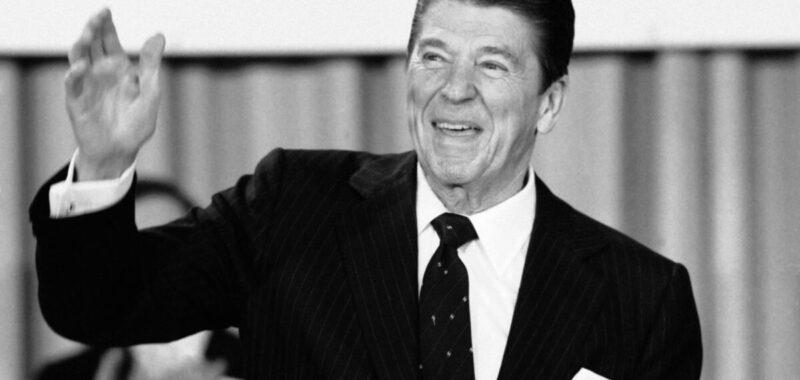Project 2025, the Heritage Foundation’s conservative playbook that would overhaul much of the federal government under a second Trump administration, has sparked fear and concern from voters despite the former president’s attempt to distance his campaign from the plan. But while Project 2025 might seem radical, most of it is not new. Instead, the now-famous document seeks to reanimate many of the worst racial, economic and political instincts of the Reagan Revolution.
Project 2025 begins with its authors (one of whom stepped down last month) boasting of the Heritage Foundation’s 1981 publication “The Mandate for Leadership,” which helped shape the Reagan administration’s policy framework. It hit its mark: Reagan wrote 60% of its recommendations into public policy in his first year in office, according to the Heritage Foundation. Yet the 900-plus-page Project 2025, itself a major component of a new edition of “The Mandate for Leadership,” does not contain any analysis of the economic and social price Americans paid for the revolution the Heritage Foundation and Reagan inspired.
If today’s economic inequality, racial unrest and environmental degradation represent some of our greatest political challenges, we would do well to remember that Reagan and the Heritage Foundation were the preeminent engineers of these catastrophes. Perhaps no day in Reagan’s presidency better embodied his policy transformations or the political ambitions of the Heritage Foundation than Aug. 13, 1981, when Reagan signed his first budget.
This budget dramatically transformed governmental priorities and hollowed out the nation’s 50-year pursuit of government for the common good that began during the New Deal. Once passed, it stripped 400,000 poor working families of their welfare benefits, while removing significant provisions from another 300,000. Radical cuts in education affected 26 million students. The number of poor Americans increased by 2.2 million, and the percentage of Black Americans living in poverty rose to a staggering 34.2%.
Of course, this was just the beginning of Reagan’s war on the poor, the environment and education. Following a Heritage Foundation plan, the Environmental Protection Agency’s operating budget would fall by 27%, and its science budget decreased by more than 50%. Funding for programs by the Department of Housing and Urban Development that provided housing assistance would be cut by 70%, according to Matthew Desmond’s “Poverty, By America.” Homelessness skyrocketed. And, as Project 2025 proposes, Reagan attempted to eliminate the Department of Education but settled for gutting its funding in a manner that set public education, in the words of author Jonathan Kozol, “back almost 100 years.” As funding for these issues nosedived under Reagan, financial support for the “war on drugs” skyrocketed and the prison population nearly doubled.
All the while, protections provided to the wealthy ballooned. Tax rates on personal income, corporate revenue and capital gains plummeted. For example, the highest income tax rate when Reagan took office was 70%. He would eventually lower it to 33%.
To ensure that wealth would be a long-lived family entitlement, Reagan instituted a 300% increase in inheritance tax protections through estate tax exemptions in his first budget. In 1980, the exemption stood at $161,000. By the time Reagan left office in 1989 it was $600,000. Today it is $13,610,000. This means that today nearly all wealthy children enjoy tax-free access to generational wealth.
And beginning during Reagan’s presidency, the number of millionaires and billionaires multiplied, increasing 225% and 400%, respectively, while the poverty of Americans across racial lines intensified. Even white males were more likely to be poor following Reagan’s presidency. Today poverty is the fourth-leading cause of death in the U.S., even though this is the wealthiest nation in the world.
If we feel like we live in a country that isn’t working for anyone who isn’t wealthy, these are some of the core reasons why. Looking back at the Reagan era and the Heritage Foundation’s original “Mandate for Leadership,” we must remember that our domestic wounds are largely self-inflicted, results of buying into racial, economic and environmental lies that continue to be sold. It is precisely the types of policies that devastated the nation during the Reagan administration that Project 2025 now seeks to resuscitate. Perhaps the only truly new thing Project 2025 suggests is using more authoritarian means to enact its agenda.
History has hinges, moments that change the trajectory of nations. The greatest progress in our country has almost always emerged during turbulent times. It is up to the United States’ most committed believers to close the door on terror and trauma and open one that leads to new democratic possibilities.
Our current moment represents more than an election. It is a turning point that has the potential to transform the United States for generations to come. We don’t need the version of the past that Project 2025 is trying to sell us. It didn’t work for most Americans then, and it won’t work for most of us now. But perhaps Project 2025 is the push the Democratic Party needed. While the Republican Party veers further into authoritarianism, Democrats must be equally determined to develop a truly equitable democracy and bind the wounds of a deeply divided nation.
Joel Edward Goza, a professor of ethics at Simmons College of Kentucky, is the author of the forthcoming book “Rebirth of a Nation: Reparations and Remaking America.”

